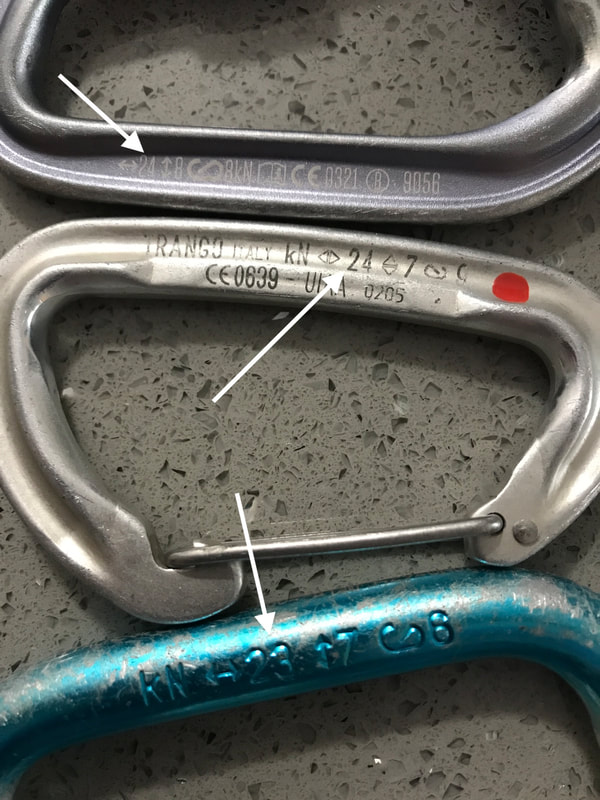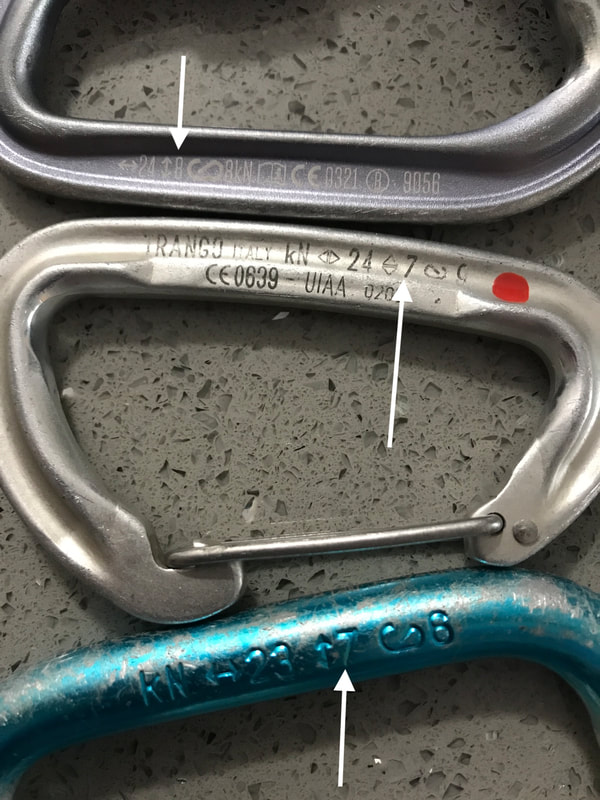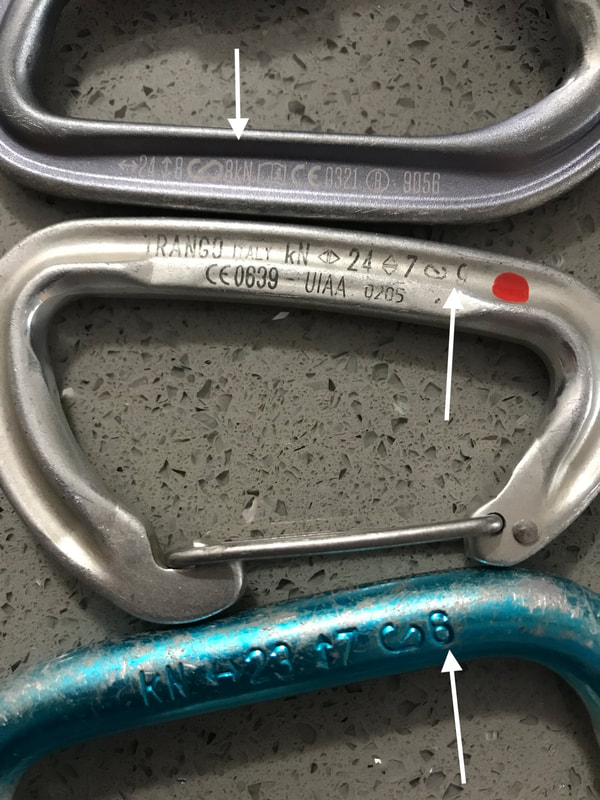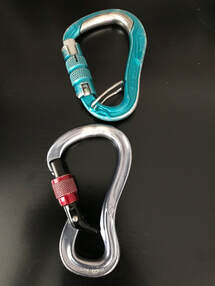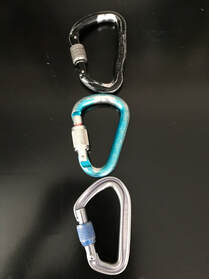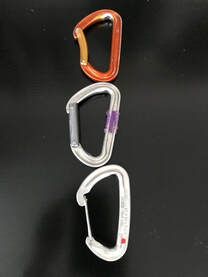If you are new to climbing, you may look at the size of some carabiners on the market and wonder how it’s possible to trust your life to them. It seems like every year they get lighter and smaller.
Any carabiner that is meant to be used in rock climbing will have a series of numbers and markings on the spine (the side of the carabiner opposite the gate). If you look closely, you will see 3 sets of numbers followed by the letters kN. Of those 3 sets of numbers, one set will have arrows that run vertically, another set will have arrows that run horizontal, and the last set will have a picture of a carabiner with the gate open.
Any carabiner that is meant to be used in rock climbing will have a series of numbers and markings on the spine (the side of the carabiner opposite the gate). If you look closely, you will see 3 sets of numbers followed by the letters kN. Of those 3 sets of numbers, one set will have arrows that run vertically, another set will have arrows that run horizontal, and the last set will have a picture of a carabiner with the gate open.
|
|
DO THE MATH
The kN stands for kilo-newton which is a way to measure the force your carabiner can safely withstand. One kilo-newton is equal to approximately 225 pounds of force. If you look at the first set of numbers (which should be the highest), the vertical arrows that run parallel with the spine signify the amount of force the carabiner can withstand on its major axis with the gate closed. If, for example, the number reads 24 kN, it means that if the carabiner is closed and loaded end to end, it can withstand approximately 5,400 pounds of force before it becomes inoperable.
The next set of numbers should decrease significantly, maybe even by less than a third, followed by arrows that run horizontally across the spine of the carabiner. This is called the minor axis and the number shows how much strength the carabiner possesses when outward force is applied on the gate and spine - which is called cross-loading. If the marking reads 7 kN, this means that if loaded in a horizontal position (cross-loaded) the carabiner’s strength would drop to withstand only 1,575 pounds of force.
The last set of numbers should be closer to the second set, maybe off by one or two digits. This strength rating is usually followed by a tiny picture of a carabiner with its gate open. This is known as its open gate strength and once again, it can be reduced by as much as a third of its full strength. If we used 8 kN as the example, the carabiner could withstand approximately 1,800 pounds of force.
The last set of numbers should be closer to the second set, maybe off by one or two digits. This strength rating is usually followed by a tiny picture of a carabiner with its gate open. This is known as its open gate strength and once again, it can be reduced by as much as a third of its full strength. If we used 8 kN as the example, the carabiner could withstand approximately 1,800 pounds of force.
This FORCES GENERATED VERSUS DEAD WEIGHT
It’s important to note that there is a difference between pounds of force (what your climbing gear is rated for) and static weight. Pounds of force would be the amount of dynamic weight applied to a carabiner (for example, in the event of a fall). Static weight would mean just hanging that same weight from the carabiner (sometimes known as a working load). This is why carabiners rated for climbing should only be used in climbing and not in other applications such as wenching or industrial settings. There are specially-made carabiners rated for those applications, often made of steel as it is stronger than aluminum. They weigh considerably more but can handle industrial abuse. In any case, if you had to apply strong forces to your carabiners for something other than climbing, it’s best to retire them after use.
CERTIFICATIONS
Finally, most carabiners will also have the CE certification and/or UIAA certification stamped near the strength ratings. There is ample information out there about these markings but for simplicity’s sake, these certifications mean the hardware you are using meets the minimum safety requirements for climbing and mountaineering practices. Though technically they are not a requirement for carabiners to be sold in the United States, beware of carabiners without at least one of these certifications. Where money is concerned, your life is worth the extra couple dollars for carabiners manufactured from reputable companies willing to put their equipment through the proper testing and certification processes.
In closing, remember that carabiners rated for climbing are the strongest when loaded along their vertical axis with the gate closed. Even though the kilo-newton rating may seem high for the minor and open gate ratings, forces generated in falls can easily reach or exceed the carabiner's lesser strength ratings. This is evident particularly in short falls when there is less rope out to absorb the impact force generated by a falling climber.
It’s important to note that there is a difference between pounds of force (what your climbing gear is rated for) and static weight. Pounds of force would be the amount of dynamic weight applied to a carabiner (for example, in the event of a fall). Static weight would mean just hanging that same weight from the carabiner (sometimes known as a working load). This is why carabiners rated for climbing should only be used in climbing and not in other applications such as wenching or industrial settings. There are specially-made carabiners rated for those applications, often made of steel as it is stronger than aluminum. They weigh considerably more but can handle industrial abuse. In any case, if you had to apply strong forces to your carabiners for something other than climbing, it’s best to retire them after use.
CERTIFICATIONS
Finally, most carabiners will also have the CE certification and/or UIAA certification stamped near the strength ratings. There is ample information out there about these markings but for simplicity’s sake, these certifications mean the hardware you are using meets the minimum safety requirements for climbing and mountaineering practices. Though technically they are not a requirement for carabiners to be sold in the United States, beware of carabiners without at least one of these certifications. Where money is concerned, your life is worth the extra couple dollars for carabiners manufactured from reputable companies willing to put their equipment through the proper testing and certification processes.
In closing, remember that carabiners rated for climbing are the strongest when loaded along their vertical axis with the gate closed. Even though the kilo-newton rating may seem high for the minor and open gate ratings, forces generated in falls can easily reach or exceed the carabiner's lesser strength ratings. This is evident particularly in short falls when there is less rope out to absorb the impact force generated by a falling climber.
CARABINER TYPES/EXAMPLES
|
Belay Locking Carabiners
Belay carabiners are specialized locking carabiners used specifically for belaying. The bottom part of the carabiner is secured around the harness's belay loop to prevent cross-loading (which as you read above, significantly decreases the strength of the carabiner.)
Some people argue against having a belaying-specific carabiner, but we always have a locking carabiner dedicated to belaying. Why not have one that doesn't twist into bad positions? The top carabiner in the photo is the Edelrid Bulletproof Twist-locking belay carabiner (link below). The "bulletproof" element refers to the stainless steel top which does not rub aluminum off on the rope, keeping the rope cleaner. The carabiner also lasts much longer because the top portion of the carabiner - where the rope goes - does not get worn down. This is a twist-style locking gate, which autolocks. These can be a challenge to learn to open with one hand, but it gets easier with practice and your carabiner will automatically lock. The bottom carabiner in the photo is the Black Diamond Gridlock Screwgate Locking Carabiner (second link below). This is a screw style locker where you have to screw or unscrew (up or down) to lock or unlock the gate. Links to rated locking belay carabiners for climbing |
Locking Carabiners
Locking carabiners are often used on critical climbing systems such as anchors. These are also frequently used for belaying. The disadvantage of using these for belaying is they often twist around and cross-load while belaying.
There are different styles of locks on locking carabiners. All three in the above photo are screw-gate locks. These are not "auto-locking" and require you to screw the mechanism to lock or unlock the carabiner. There are also a variety of auto-locking mechanisms available (some of which are described under the belay locking carabiner column.) Links to rated locking carabiners for rock climbing |
Non-Locking Carabiners
Non-locking carabiners are typically used for draws.
Bent gate draws (the orange top carabiner, which is the Petzl Spirit - link below) are often used in sport "quick draws" as the bottom draw where the rope goes through. The bent gate can make the rope "clipping" smoother. The middle "straight gate" style carabiner is more generic and is often used in the top of a sport quick draw that clips into the bolt on the wall. These are also often used in alpine draws and sometimes as the bottom carabiner in a sport "quick draw." The wire gate carabiners (the bottom silver carabiner) often weigh less and are typically used on extendable "alpine" draws for traditional climbing. Links to non-locking rated carabiners for climbing |
|
|

